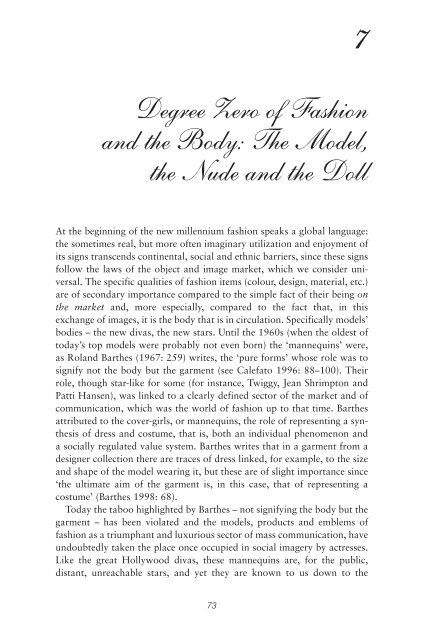You also want an ePaper? Increase the reach of your titles
YUMPU automatically turns print PDFs into web optimized ePapers that Google loves.
Degree Zero of Fashion<br />
and the <strong>Body</strong>: <strong>The</strong> Model,<br />
the Nude and the Doll<br />
At the beginning of the new millennium fashion speaks a global language:<br />
the sometimes real, but more often imaginary utilization and enjoyment of<br />
its signs transcends continental, social and ethnic barriers, since these signs<br />
follow the laws of the object and image market, which we consider universal.<br />
<strong>The</strong> specific qualities of fashion items (colour, design, material, etc.)<br />
are of secondary importance compared to the simple fact of their being on<br />
the market and, more especially, compared to the fact that, in this<br />
exchange of images, it is the body that is in circulation. Specifically models’<br />
bodies – the new divas, the new stars. Until the 1960s (when the oldest of<br />
today’s top models were probably not even born) the ‘mannequins’ were,<br />
as Roland Barthes (1967: 259) writes, the ‘pure forms’ whose role was to<br />
signify not the body but the garment (see Calefato 1996: 88–100). <strong>The</strong>ir<br />
role, though star-like for some (for instance, Twiggy, Jean Shrimpton and<br />
Patti Hansen), was linked to a clearly defined sector of the market and of<br />
communication, which was the world of fashion up to that time. Barthes<br />
attributed to the cover-girls, or mannequins, the role of representing a synthesis<br />
of dress and costume, that is, both an individual phenomenon and<br />
a socially regulated value system. Barthes writes that in a garment from a<br />
designer collection there are traces of dress linked, for example, to the size<br />
and shape of the model wearing it, but these are of slight importance since<br />
‘the ultimate aim of the garment is, in this case, that of representing a<br />
costume’ (Barthes 1998: 68).<br />
Today the taboo highlighted by Barthes – not signifying the body but the<br />
garment – has been violated and the models, products and emblems of<br />
fashion as a triumphant and luxurious sector of mass communication, have<br />
undoubtedly taken the place once occupied in social imagery by actresses.<br />
Like the great Hollywood divas, these mannequins are, for the public,<br />
distant, unreachable stars, and yet they are known to us down to the<br />
73<br />
7

















